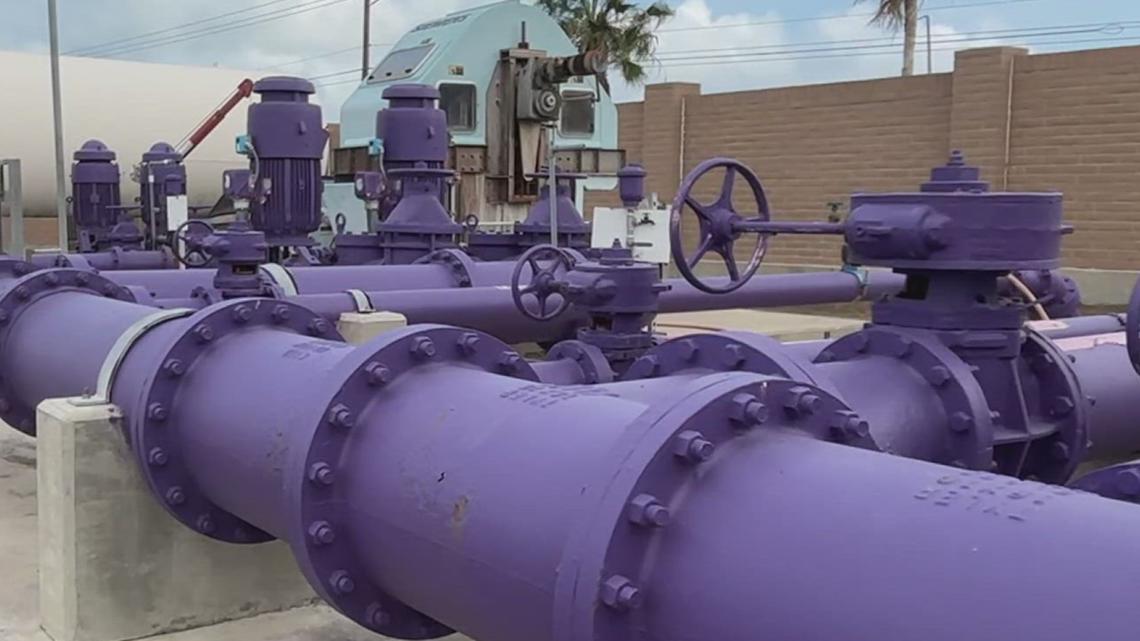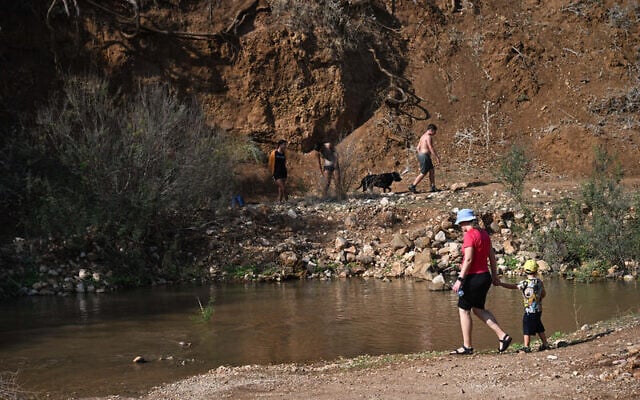Flint Hills, Valero and Citgo want in on Corpus Christi’s new water plan according to the city manager – kiiitv.com

Report on the Corpus Christi Wastewater Recycling Initiative and Sustainable Water Management
Project Overview and Strategic Objectives
In response to severe drought conditions and increasing water scarcity in South Texas, the City of Corpus Christi has initiated a strategic plan to enhance water resilience. The project focuses on recycling treated wastewater for industrial use, thereby conserving the region’s limited potable water supply for public consumption. This initiative represents a critical step towards sustainable resource management and climate change adaptation.
- Objective: To create a new, drought-proof water source for industrial customers by recycling treated municipal wastewater.
- Mechanism: The plan involves constructing a pipeline to divert treated effluent, which is currently discharged into Oso Bay, to the Greenwood and Saratoga wastewater treatment facilities. From there, it will be supplied to industrial partners.
- Projected Impact: The initiative is expected to free up approximately 16 million gallons of potable water per day for the city’s distribution system within two years, directly benefiting residents and alleviating pressure on existing water sources.
Implementation and Financial Framework
The project is structured as a public-private partnership, dividing the financial and logistical responsibilities between the municipality and industrial stakeholders. The Corpus Christi City Council has demonstrated unanimous support by approving the initial phase.
- Phase One (Municipal): The City of Corpus Christi will be responsible for designing and constructing the primary pipeline segment.
- Design Fee: $11 million
- Estimated Construction Cost: $100 million
- Phase Two (Industrial): Industrial partners, including Valero, Flint Hills, and Citgo, have expressed interest in constructing a second pipeline connecting the Greenwood facility to their respective operations.
- Estimated Construction Cost: $100 million or more
- Timeline: Following a 9-0 council vote to hire a design and engineering firm, groundbreaking for the first pipeline segment is anticipated within the next year.
Contribution to Sustainable Development Goals (SDGs)
This water recycling initiative directly addresses several United Nations Sustainable Development Goals, positioning Corpus Christi as a leader in sustainable urban water management.
- SDG 6: Clean Water and Sanitation: The project is a direct implementation of Target 6.4, which calls for substantially increasing water-use efficiency and ensuring sustainable withdrawals of freshwater. By creating a circular water economy, the city reduces its reliance on strained natural water sources and improves the long-term sustainability of its water supply.
- SDG 9: Industry, Innovation, and Infrastructure: The initiative promotes Target 9.4 by upgrading infrastructure to support sustainable industrial processes. Providing recycled water allows industries to reduce their freshwater footprint, fostering a more sustainable and resource-efficient industrial sector.
- SDG 11: Sustainable Cities and Communities: By securing a resilient water source independent of rainfall, the project strengthens the city’s capacity to adapt to the adverse impacts of climate change, specifically drought, in line with Target 11.B. This enhances the overall sustainability and security of the urban community.
- SDG 12: Responsible Consumption and Production: The plan embodies the principles of Target 12.2, which aims for the sustainable management and efficient use of natural resources. Reusing treated wastewater is a key strategy for achieving more sustainable production patterns in water-intensive industries.
- SDG 17: Partnerships for the Goals: The project’s success relies on a robust public-private partnership between the City of Corpus Christi and major industrial companies. This collaboration is a model for achieving sustainable development objectives through shared investment and responsibility, as encouraged by SDG 17.
SDGs Addressed or Connected
The following Sustainable Development Goals (SDGs) are relevant to the article:
-
SDG 6: Clean Water and Sanitation
The entire article focuses on managing water resources in the face of scarcity. The city’s plan to recycle treated wastewater directly addresses the core themes of this goal, which include water quality, water-use efficiency, and integrated water resources management.
-
SDG 9: Industry, Innovation and Infrastructure
The project involves a significant investment in new infrastructure, specifically a “long pipeline” costing over $200 million in total. It represents an innovative approach to support industrial customers (refineries) while making their processes more sustainable through the use of recycled water.
-
SDG 11: Sustainable Cities and Communities
The initiative is a city-led effort to make Corpus Christi more resilient to the impacts of drought. By securing the water supply for residents and industry, the plan enhances the city’s sustainability and its ability to cope with water-related disasters.
-
SDG 12: Responsible Consumption and Production
The plan promotes a circular economy model for water. Instead of discharging treated wastewater into Oso Bay, it is repurposed for industrial use. This reduces the demand for fresh, drinkable water from industries, promoting more efficient and responsible use of a vital natural resource.
-
SDG 13: Climate Action
The article mentions that the water supply is shrinking due to a drought where “storm clouds that haven’t shown up in months.” This context links the water scarcity issue to climate-related hazards. The city’s project is a direct adaptation strategy to strengthen resilience against the impacts of drought.
Specific Targets Identified
Based on the article’s content, the following specific SDG targets can be identified:
-
Target 6.3: Improve water quality by substantially increasing recycling and safe reuse.
The article’s central theme is the city’s plan to “recycle treated wastewater and pump millions of gallons back into daily use.” The project aims to reroute treated wastewater, which currently flows into Oso Bay, and turn it into a new source for industrial customers, directly aligning with the goal of increasing water recycling and reuse.
-
Target 6.4: Substantially increase water-use efficiency and address water scarcity.
The project’s primary goal is to “squeeze a little more life out of a shrinking water supply” caused by drought. By providing recycled water to industry, the city gets to “save its drinkable supply,” which could “free up 16 million gallons a day.” This directly increases water-use efficiency across sectors (municipal and industrial) and addresses water scarcity for the public.
-
Target 9.1: Develop quality, reliable, sustainable and resilient infrastructure.
The plan requires the construction of significant new infrastructure, including a “long pipeline” with an initial segment costing about “$100 million.” This infrastructure is designed to create a resilient and sustainable water supply system for the city and its industries in the face of ongoing drought.
-
Target 11.5: Reduce the impact of water-related disasters.
The article frames the project as a necessary response to a drought that “keeps tightening the screws.” By creating an alternative water source and conserving the potable supply, the city is actively implementing a plan to mitigate the effects of a water-related disaster on its population and economy.
-
Target 13.1: Strengthen resilience and adaptive capacity to climate-related hazards.
The water recycling plan is a clear example of a community building its adaptive capacity to a climate-related hazard. The drought is the hazard, and the project is a tangible action to “keep its water future from running aground,” thereby strengthening the city’s resilience.
Indicators Mentioned or Implied
The article mentions or implies several indicators that can measure progress towards the identified targets:
-
Volume of treated wastewater reused (Indicator for Target 6.3)
The article provides a specific quantitative measure for this. Mayor Paulette Guajardo states the move could divert treated water for industrial use, freeing up “16 million gallons a day.” This figure serves as a direct indicator of the volume of wastewater being recycled and reused.
-
Change in water stress (Indicator for Target 6.4)
The “16 million gallons a day” of drinkable water saved for public use is a direct measure of the reduction in water stress on the municipal supply. This quantifies the increase in the availability of freshwater for residents.
-
Investment in sustainable infrastructure (Indicator for Target 9.1)
The article provides clear financial data that can be used as an indicator of investment. It mentions an “$11 million design fee,” a construction cost of about “$100 million” for the city’s section of the pipeline, and “another $100 million or more” for the industry’s section. These figures represent a substantial investment in resilient infrastructure.
-
Adoption and implementation of local disaster risk reduction strategies (Indicator for Target 11.5)
The article states that the City “Council voted 9-0 in favor of hiring a firm to design and engineer the city’s part of the pipeline.” This unanimous vote represents the formal adoption and the first step in the implementation of a local strategy to reduce the risk and impact of the ongoing drought.
SDGs, Targets, and Indicators Analysis
| SDGs | Targets | Indicators |
|---|---|---|
| SDG 6: Clean Water and Sanitation | 6.3: Substantially increase recycling and safe reuse of water. 6.4: Increase water-use efficiency and address water scarcity. |
– Volume of recycled wastewater: 16 million gallons per day. – Volume of potable water saved for public use: 16 million gallons per day. |
| SDG 9: Industry, Innovation and Infrastructure | 9.1: Develop quality, reliable, sustainable and resilient infrastructure. | – Total investment in new pipeline infrastructure: ~$211+ million ($11M design + $100M city + $100M+ industry). |
| SDG 11: Sustainable Cities and Communities | 11.5: Reduce the impact of water-related disasters. | – Adoption of a local disaster risk reduction strategy: Confirmed by a 9-0 City Council vote to proceed with the project. |
| SDG 12: Responsible Consumption and Production | 12.2: Achieve the sustainable management and efficient use of natural resources. | – Creation of a circular water economy where treated wastewater is supplied to industrial customers (Valero, Flint Hills, Citgo). |
| SDG 13: Climate Action | 13.1: Strengthen resilience and adaptive capacity to climate-related hazards. | – Implementation of a drought adaptation project to secure the city’s water supply. |
Source: kiiitv.com
What is Your Reaction?
 Like
0
Like
0
 Dislike
0
Dislike
0
 Love
0
Love
0
 Funny
0
Funny
0
 Angry
0
Angry
0
 Sad
0
Sad
0
 Wow
0
Wow
0
















































:focal(1500,1000)/https://media.globalcitizen.org/a6/9a/a69a4720-d8a1-4715-b596-18738d03c05c/rotary_polio_hero_image.jpg?#)







/countries/sri-lanka/photo-credit---dmc-sri-lanka.tmb-1200v.jpg?sfvrsn=dc298bcc_1#)



















